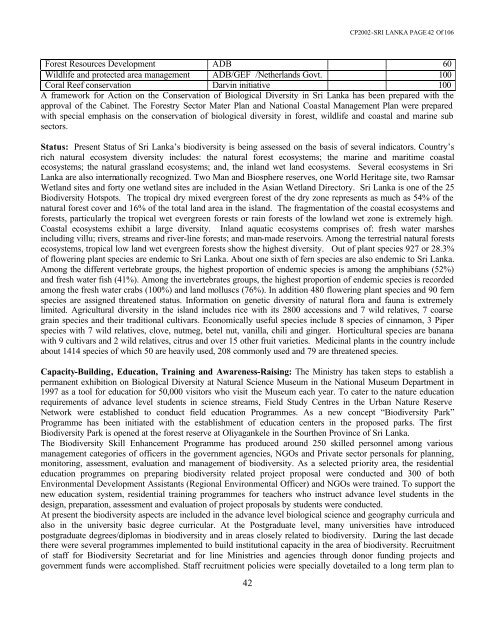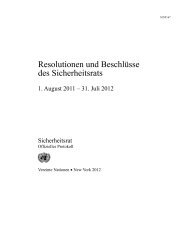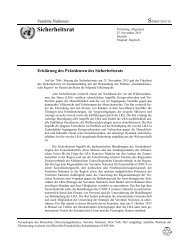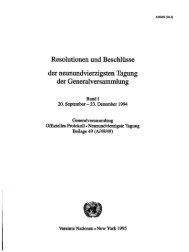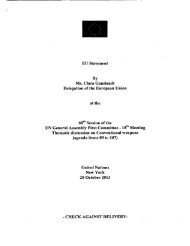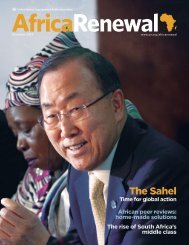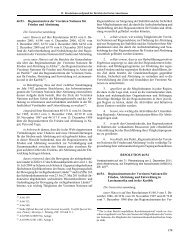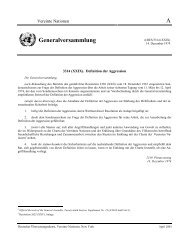SRI LANKA COUNTRY PROFILE
SRI LANKA COUNTRY PROFILE
SRI LANKA COUNTRY PROFILE
You also want an ePaper? Increase the reach of your titles
YUMPU automatically turns print PDFs into web optimized ePapers that Google loves.
42<br />
CP2002-<strong>SRI</strong> <strong>LANKA</strong> PAGE 42 Of 106<br />
Forest Resources Development ADB 60<br />
Wildlife and protected area management ADB/GEF /Netherlands Govt. 100<br />
Coral Reef conservation Darvin initiative 100<br />
A framework for Action on the Conservation of Biological Diversity in Sri Lanka has been prepared with the<br />
approval of the Cabinet. The Forestry Sector Mater Plan and National Coastal Management Plan were prepared<br />
with special emphasis on the conservation of biological diversity in forest, wildlife and coastal and marine sub<br />
sectors.<br />
Status: Present Status of Sri Lanka’s biodiversity is being assessed on the basis of several indicators. Country’s<br />
rich natural ecosystem diversity includes: the natural forest ecosystems; the marine and maritime coastal<br />
ecosystems; the natural grassland ecosystems; and, the inland wet land ecosystems. Several ecosystems in Sri<br />
Lanka are also internationally recognized. Two Man and Biosphere reserves, one World Heritage site, two Ramsar<br />
Wetland sites and forty one wetland sites are included in the Asian Wetland Directory. Sri Lanka is one of the 25<br />
Biodiversity Hotspots. The tropical dry mixed evergreen forest of the dry zone represents as much as 54% of the<br />
natural forest cover and 16% of the total land area in the island. The fragmentation of the coastal ecosystems and<br />
forests, particularly the tropical wet evergreen forests or rain forests of the lowland wet zone is extremely high.<br />
Coastal ecosystems exhibit a large diversity. Inland aquatic ecosystems comprises of: fresh water marshes<br />
including villu; rivers, streams and river-line forests; and man-made reservoirs. Among the terrestrial natural forests<br />
ecosystems, tropical low land wet evergreen forests show the highest diversity. Out of plant species 927 or 28.3%<br />
of flowering plant species are endemic to Sri Lanka. About one sixth of fern species are also endemic to Sri Lanka.<br />
Among the different vertebrate groups, the highest proportion of endemic species is among the amphibians (52%)<br />
and fresh water fish (41%). Among the invertebrates groups, the highest proportion of endemic species is recorded<br />
among the fresh water crabs (100%) and land molluscs (76%). In addition 480 flowering plant species and 90 fern<br />
species are assigned threatened status. Information on genetic diversity of natural flora and fauna is extremely<br />
limited. Agricultural diversity in the island includes rice with its 2800 accessions and 7 wild relatives, 7 coarse<br />
grain species and their traditional cultivars. Economically useful species include 8 species of cinnamon, 3 Piper<br />
species with 7 wild relatives, clove, nutmeg, betel nut, vanilla, chili and ginger. Horticultural species are banana<br />
with 9 cultivars and 2 wild relatives, citrus and over 15 other fruit varieties. Medicinal plants in the country include<br />
about 1414 species of which 50 are heavily used, 208 commonly used and 79 are threatened species.<br />
Capacity-Building, Education, Training and Awareness-Raising: The Ministry has taken steps to establish a<br />
permanent exhibition on Biological Diversity at Natural Science Museum in the National Museum Department in<br />
1997 as a tool for education for 50,000 visitors who visit the Museum each year. To cater to the nature education<br />
requirements of advance level students in science streams, Field Study Centres in the Urban Nature Reserve<br />
Network were established to conduct field education Programmes. As a new concept “Biodiversity Park”<br />
Programme has been initiated with the establishment of education centers in the proposed parks. The first<br />
Biodiversity Park is opened at the forest reserve at Oliyagankele in the Sourthen Province of Sri Lanka.<br />
The Biodiversity Skill Enhancement Programme has produced around 250 skilled personnel among various<br />
management categories of officers in the government agencies, NGOs and Private sector personals for planning,<br />
monitoring, assessment, evaluation and management of biodiversity. As a selected priority area, the residential<br />
education programmes on preparing biodiversity related project proposal were conducted and 300 of both<br />
Environmental Development Assistants (Regional Environmental Officer) and NGOs were trained. To support the<br />
new education system, residential training programmes for teachers who instruct advance level students in the<br />
design, preparation, assessment and evaluation of project proposals by students were conducted.<br />
At present the biodiversity aspects are included in the advance level biological science and geography curricula and<br />
also in the university basic degree curricular. At the Postgraduate level, many universities have introduced<br />
postgraduate degrees/diplomas in biodiversity and in areas closely related to biodiversity. During the last decade<br />
there were several programmes implemented to build institutional capacity in the area of biodiversity. Recruitment<br />
of staff for Biodiversity Secretariat and for line Ministries and agencies through donor funding projects and<br />
government funds were accomplished. Staff recruitment policies were specially dovetailed to a long term plan to


